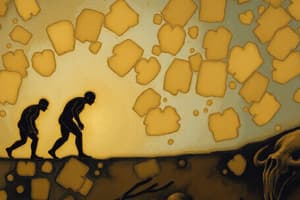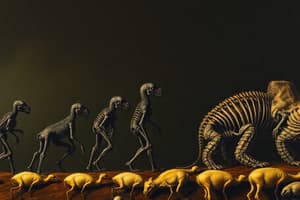Podcast
Questions and Answers
What is the core process described in Darwin's theory of natural selection?
What is the core process described in Darwin's theory of natural selection?
- Mutation
- Natural selection (correct)
- Gene flow
- Genetic drift
According to Darwin, what happens to species over many generations as a result of natural selection?
According to Darwin, what happens to species over many generations as a result of natural selection?
- They remain unchanged
- They become weaker
- They lose all genetic diversity
- They evolve as favorable traits become more common (correct)
What key concept is at the heart of evolution by natural selection?
What key concept is at the heart of evolution by natural selection?
- Variation (correct)
- Genetic engineering
- Migration
- Extinction
Which of the following is NOT a component of evolution by natural selection?
Which of the following is NOT a component of evolution by natural selection?
What groundbreaking work did Charles Darwin publish in 1859 outlining his theory of natural selection?
What groundbreaking work did Charles Darwin publish in 1859 outlining his theory of natural selection?
Which mechanism explains how species change over time through processes like natural selection?
Which mechanism explains how species change over time through processes like natural selection?
What provides the selective pressures that drive evolution?
What provides the selective pressures that drive evolution?
Which evidence of evolution involves similarities in the structure of different species' bones and organs?
Which evidence of evolution involves similarities in the structure of different species' bones and organs?
What does the fossil record reveal about the progression of life forms?
What does the fossil record reveal about the progression of life forms?
Which concept combines Darwin's theory of natural selection with genetic drift and gene flow?
Which concept combines Darwin's theory of natural selection with genetic drift and gene flow?
What does molecular evidence, such as DNA or protein sequences, reveal about species?
What does molecular evidence, such as DNA or protein sequences, reveal about species?
How do offspring inherit traits from their parents?
How do offspring inherit traits from their parents?
Study Notes
Evolution: A Time-Honored Theory of Life's Origins and Transformations
Evolution is a fundamental concept in biology that has transformed our understanding of life on Earth. It explains how species change over time through processes like natural selection, genetic drift, and gene flow. In this comprehensive guide, we will delve into the fascinating world of evolution, exploring its history, key concepts, evidence, and modern interpretations.
Darwin's Theory of Evolution
Charles Darwin's groundbreaking work, "On the Origin of Species," published in 1859, introduced his theory of natural selection. This theory posits that organisms with traits beneficial for their environment are more likely to survive and reproduce, passing these advantageous traits onto their offspring. Over many generations, species evolve as favorable traits become more common and less favorable traits are lost due to natural selection.
Natural Selection
At the core of Darwin's theory lies natural selection. This process occurs when organisms with advantageous traits have higher chances of survival and reproduction compared to those without such traits. Over time, these beneficial traits become more prevalent in the population, leading to changes in species' genetic makeup.
Evolution by Natural Selection
Evolution by natural selection involves several key components: variation, inheritance, and environmental change. Variation arises through genetic mutations, while inheritance ensures that offspring receive traits from their parents. Environmental change provides the selective pressures that make certain traits advantageous or disadvantageous, driving evolution.
Evidence of Evolution
Several lines of evidence support the theory of evolution. These include:
- Fossil record: The fossil record reveals a progressive sequence of life forms, with transitional species linking different groups.
- Comparative anatomy: Similarities in the structure of different species' bones, organs, and other features provide evidence of shared ancestry.
- Comparative embryology: The development of embryos of different species reveals similarities that suggest a common ancestry.
- Biogeography: The distribution of species across geographical regions mirrors their evolutionary relationships.
- Molecular evidence: Comparisons of genetic material, such as DNA or protein sequences, reveal patterns of common descent and divergence.
Fossil Record
The fossil record plays a crucial role in understanding the evolutionary history of life on Earth. Fossils provide evidence of extinct species and their relationships to modern organisms, allowing scientists to trace the emergence and diversification of life over billions of years.
Modern Synthesis
The modern synthesis, or neo-Darwinism, is a comprehensive framework that combines Darwin's theory of natural selection with other evolutionary concepts, such as genetic drift and gene flow. This synthesis has been further refined by the incorporation of molecular and ecological data, resulting in a robust and well-supported understanding of evolution.
In conclusion, evolution is a well-established scientific theory that explains the origin and transformation of life on Earth. Through the concepts of natural selection, genetic drift, and gene flow, the modern synthesis provides a comprehensive framework for understanding the diverse array of species that inhabit our planet.
Studying That Suits You
Use AI to generate personalized quizzes and flashcards to suit your learning preferences.
Description
Test your knowledge on the theory of evolution, evidence supporting it, and the modern synthesis that combines key evolutionary concepts. Explore topics like natural selection, fossil records, comparative anatomy, and molecular evidence.




